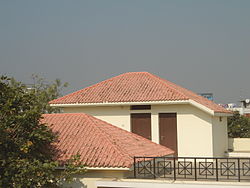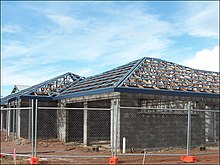Hip roof
This article includes a list of generalreferences,butit lacks sufficient correspondinginline citations.(August 2013) |


Ahip roof,hip-roof[1]orhipped roof,is a type ofroofwhere all sides slope downwards to the walls, usually with a fairly gentle slope, with variants includingtented roofsand others.[2]Thus, a hipped roof has nogablesor other vertical sides to the roof.
A square hip roof is shaped like apyramid.Hip roofs on houses may have two triangular sides and twotrapezoidalones. A hip roof on a rectangular plan has four faces. They are almost always at the same pitch or slope, which makes them symmetrical about the centerlines. Hip roofs often have a consistent levelfascia,meaning that a gutter can be fitted all around. Hip roofs often havedormerslanted sides.
Construction
[edit]


Hip roofs can be constructed on a wide variety of plan shapes. Each ridge is central over the rectangle of the building below it. The triangular faces of the roof are called the hip ends, and they are bounded by the hips themselves. The "hips" andhiprafters sit on an external corner of the building and rise to the ridge. Where the building has an internal corner, a valley makes the join between the sloping surfaces (and is underlain by avalley rafter). Hip roofs have the advantage of giving a compact, solid appearance to a structure. The roof pitch (slope) may vary.
Use
[edit]In modern domestic architecture, hip roofs are commonly seen inbungalowsandcottages,and have been integral to styles such as theAmerican Foursquare.However, they have been used in many styles of architecture and in a wide array of structures.
Advantages and disadvantages
[edit]
A hip roof is self-bracing, requiring lessdiagonal bracingthan agable roof.Hip roofs are thus much more resistant to wind damage than gable roofs. Hip roofs have no large, flat, or slab-sided ends to catch wind and are inherently much more stable than gable roofs. However, for a hurricane region, the roof also has to be steep-sloped; at least 35 degrees from horizontal or steeper in slope is preferred. When wind flows over a shallow sloped hip roof, the roof can behave like an airplane wing. Lift is then created on the leeward side. The flatter the roof, the more likely this will happen. A steeper pitched hip roof tends to cause the wind to stall as it goes over the roof, breaking up the effect. If the roof slopes are less than 35 degrees from horizontal, the roof will be subject to uplift. Greater than 35 degrees, and not only does wind blowing over it encounter a stalling effect, but the roof is actually held down on the wall plate by the wind pressure.
A disadvantage of a hip roof, compared with a gable roof on the same plan, is that there is less room inside the roof space; access is more difficult for maintenance; hip roofs are harder to ventilate; and there is not a gable with a window for natural light.[3][4]Elegant, organic additions are relatively difficult to make on houses with hip roofs.
Variants
[edit]Mansard roof
[edit]
A mansard roof is a variation on a hip roof, with two different roof angles, the lower one much steeper than the upper.
Gablet roof or Dutch gable
[edit]
Another variation is the gablet (UK terminology) or Dutch gable roof (U.S. and Australasian terminology), which has a hip with a small gable (the gablet) above it. This type simplifies the construction of the roof; no girder trusses are required, but it still has level walls and consistenteaves.
TheEast Asian hip-and-gable roofis similar in concept to the gablet roof.
Half-hip roof
[edit]
A half-hip, clipped-gable or jerkin head roof has a gable, but the upper point of the gable is replaced by a small hip, squaring off the top of the gable. The lower edge of the half-hip may have a gutter which leads back on to the remainder of the roof on one or both sides. Both the gablet roof and the half-hipped roof are intermediate between the gabled and fully hipped types: the gablet roof has a gable above a hip, while a half-hipped roof has a hip above a gable.
Half-hipped roofs are very common inEngland,Denmark,Germanyand especially inAustriaandSlovenia.They are also typical oftraditional timber-frame buildingsin theWealdenarea of South East England.
Half-hip roofs are sometimes referred to as "Dutch hip", but this term is easily confused with "Dutch gable".
Pavilion roof
[edit]A roof with equally hipped pitches on a square orregular polygonalplan having a pyramidal or almost pyramidal form.[5]Low variants are typically found toppinggazebosand otherpavilion structures.Steep tower or church tower variants are known as pyramid roofs.
Rhenish helm or Helm roof
[edit]A pointed roof seen on a spire or a tower, oriented so that it has four gable ends. See theChurch of St Mary the Blessed Virgin, Somptingin England, orSpeyer CathedralandLimburg Cathedralin Germany.
Tented roof
[edit]A tented roof is a type of polygonal hipped roof with steeply pitched slopes rising to a peak or intersection.
See also
[edit]- List of roof shapes
- Domestic roof construction
- Finial,or hip-knob
References
[edit]- ^Curl, James Stevens (2006).Oxford Dictionary of Architecture and Landscape Architecture,2nd ed., OUP, Oxford and New York, p. 364.ISBN978-0-19-860678-9.
- ^"Different Types of Hipped Roof Design - JTC Roofing - News".JTC Roofing Contractors Ltd.26 January 2016.Retrieved17 July2024.
- ^"Design and Construction Guidance for Community Safe Rooms".FEMA.Archivedfrom the original on 13 June 2013.Retrieved8 April2013.
- ^Grazulis, Thomas P. (1993).Significant tornadoes, 1680-1991.St. Johnsbury, Vt.: Environmental Films. p. 106.ISBN1-879362-03-1.
- ^"Pavilion roof".A Dictionary of Construction, Surveying and Civil Engineering.Oxford University Press. 18 April 2013.ISBN978-0-19-953446-3.

